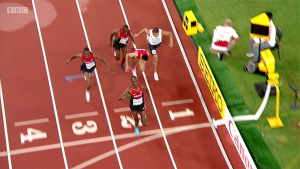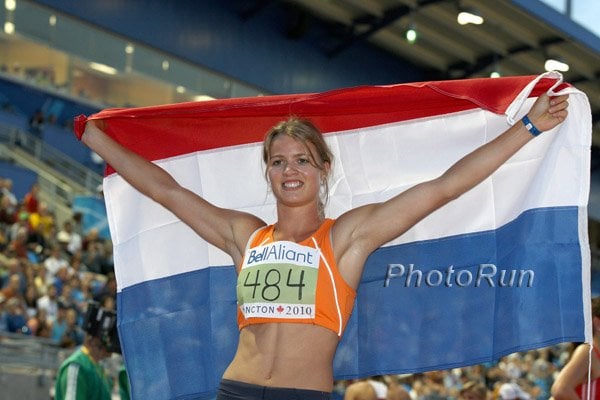WTW: Did Centro Bomb In Beijing? Is Dafne Schippers Clean? Did The US Suck In Beijing? + Ben True’s Shoes, Dennis Mitchell And More
By LetsRun.com
September 2, 2015
Well, the 2015 IAAF World Championships are in the books. We are back from the 13+ hour flight from Beijing and trying to get readjusted to the time difference quickly so we’ll be on top of our game when the first of the two Diamond League finals takes place on Thursday in Zurich. No worries, jet-lag didn’t prevent us from analyzing a few broad themes from Beijing.
Our weekly recap – the Week That Was – appears below.
Past editions of The Week That Was can be found here. Questions or comments? Please email us or post them in our running fan forum.
****
What happened to Matthew Centrowitz?
On the final day of the 2015 World champs, the US men’s last chance for a mid-d/distance medal came and went as none of the three Americans in the final came close to a medal. Given the fact that the US had medalled in the 1500 in each of the last four global championships, it didn’t take long for fans to start asking for explanations on the messageboard:
Our answer to that honestly would be, “Nothing.”
What do we mean? Well, namely that the quality of this 1500 final was way ahead of what it took to medal in other recent champs.
We decided to compare the 2015 Worlds final to the 2012 Olympics. It’s a good comparison as both races were run in eerily similar fashion. Both had a 3:34 winning time after a 1:58 half and both featured a big move by Taoufik Makhloufi with 300 meters remaining.
What was different was the result. In 2012, Makhloufi made a big move with 300 to go and absolutely made a mockery of the field as he won by .71 over Leo Manzano. This year, Makhloufi’s big move resulted in him being run down in the last 100 meters and finishing out of the medals.
Asbel Kiprop in 2015 was way better than Makhloufi in 2012 and Kiprop barely won the final as four guys finished within .41 of him.
| Kiprop vs Makhloufi | Last lap | Last 300 | Last 200 | |
|
2012 |
Makhloufi | 52.76 | 39.4 | 26.7 |
| 2015 | Kiprop | 51.6 | 38.02 |
25.7 |
The fact of the matter is Leo Manzano’s silver-medal run from 2012 or Centro’s silver-medal run from 2013 wouldn’t have sniffed a medal this year.
| Centro this year versus Centro in ’12 & 13 and Leo in ’12 | ||||
| Last lap | Last 300 | Last 200 | ||
| 2012 | Manzano | 52.9 | 39.1 | 26.4 |
| 2012 | Centro | 53.76 | 40.1 | 26.8 |
| 2013 | Centro | 53.7 | 40.15 | 26.4 |
| 2015 | Centro | 53.96 | 40.44 | 27.3 |
Yes, Centro’s close this year wasn’t quite as good as it was in 2012 or 2013, he also gave up a bit this year as he knew he wasn’t going to medal.
As we mentioned in our race recap, the guys with the six best PRs took the top six places in the 1500 final.
That’s not to say Centro couldn’t have medalled. His close at 2015 USAs was his best close ever. There, his final 800 was about 1:49 flat versus about 1:50 flat for Kiprop at Worlds but USAs was a 3:37 race and Worlds was a 3:34 race.
|
Kiprop vs Makhloufi vs. Centro |
Last lap | Last 300 | Last 200 | |
| 2012 Olympics | Makhloufi | 52.76 | 39.4 | 26.7 |
| 2015 Worlds | Kiprop | 51.6 | 38.02 | 25.7 |
| 2015 USAs | Centro | 51.9 | 38.95 |
25.6 |
****
Mid-D and Distance-Wise, Team USA Didn’t Do Quite As Well As In Recent Years, But It Could Be A Lot Worse
The mainstream media, or at least what’s left of it, has been trying to analyze what went wrong with Team USA overall at the 2015 Worlds.
We’ll do that in a minute but first wanted to look at the mid-d and distance results only.
The US only won a single mid-d/distance medal in Beijing (thank you Emily Infeld), down from four in 2013. However, on the positive side of things, the US had more finalists (21) on the track in 2015 in the 800 on up than it did it in 2011, 2012 or 2013. That being said, if you score the top 8 finishers (8 points for first, 7 for second, down to 1 for 8th), the US scored less in 2015 than it did in 2013, 2012 or 2011.
But don’t complain too much. It could be a lot worse. We decided to compare the US team’s performance this year to back in 2000, when LetsRun.com was founded. Back in 2000, the US team only had 8 finalists on the track in mid-d/distance events. That’s only half of it. In terms of top-8 finishes, the US team had a grand total of two in any mid-d distance event (a 7th in the women’s 800 and 8th in the women’s 1500). Not a single US man placed in the top 8 of anything 800 on up.
| 2015 | 2013 | 2012 | 2011 | 2000 | |
| # Finalists | 21 | 20 | 20 | 17 | 8 |
| Medals | 1 | 4 | 2 | 3 | 0 |
| Top 8 Points | 41 | 53 | 51 | 40 | 3 |
*Spreadsheet Detailing Yearly Breakdown of US Team’s Performance From 2011-2015 + 2000 Here
***
Team USA Falters Badly…. In The Hurdles
In terms of the overall meet, many were disappointed by Team USA’s dropoff in results. In 2013, the US won 25 medals (six gold, 14 silver) but this time the US won 18 (six gold, six silver).
However to blame USATF for the dropoff is too easy. USATF does little to produce Team USA medals. For the most part, the NCAA collegiate system deserves way more props for developing American stars than USATF.
The biggest shock for Team USA came with the fact that the US failed to medal at all in the women’s 100 hurdles even though the US has the five fastest women in the World in the event. The US also failed to medal in the men’s 400 hurdles, despite having the top two performers in the world coming in (Bershawn Jackson and Johnny Dutch), neither of whom made the final. Of course, even if they did, they might not have medalled as the gold and silver medalists both beat Jackson’s previous world leader (48.09).
Speaking of not winning gold, the US had to settle for silver in the women’s 4 x 400 even though it had the two fastest women in the world before Worlds in Francena McCorory (49.83) and Sanya Richards-Ross (49.95) fresh for the relay as they didn’t make the US team in the individual 400. However, after Beiing, it’s clear there is a reason why Richards-Ross and McCorory didn’t make the team. Richards-Ross was awful in the 4 x 400 final and her 51.5 split doomed Team USA. McCorory only split 50.83 in the prelims but was chosen to anchor Team USA in the final. Her anchor leg wasn’t awful (49.93) but not nearly enough to hold off Jamaica’s Novlene Williams-Mills (49.14).
Maybe the US shouldn’t have been viewed as unbeatable. After all, Jamaica did take places 3-4-5-6 in the 400 final.
Now THIS is how you start a 4×400-meter relay: http://t.co/wjaE6eEEbX pic.twitter.com/jcvVrUuPF4
— ESPN (@espn) August 30, 2015
If the US had won gold in the women’s 4 x 400 and 100 hurdles as expected and picked up another medal in the 100 hurdles and 400 hurdles, then none of the negative talk would be going on as the US would have both won the 2015 gold medal battle (Kenya and Jamaica had the most at 7) and surpassed its 2013 gold medal total as well.
The real story that people should have been writing was one that messageboard poster “Awa” picked up on quite well:
Russia, with increased PED scrutiny, went from winning the gold medal battle in 2013 with 7 to winning just 2 golds in 2015. In terms of overall medals, they fell from 17 to 4.
The US Relays Did Terrible in Beijing, But USATF Wants to Keep Dennis Mitchell
Speaking of PED scrutiny, despite the US men dropping the stick in the 4×100, a questionable order in the women’s 4×400, and a botched hand-off in the women’s 4×400, USATF told the NYTimes it had “no plans to replace” convicted drug cheat Dennis Mitchell as its paid relay coach. (That’s not to mention, the US dropping the baton in 2 of the 4 short relays at World Relays this year.) We could understand wanting to hire a former convicted doper as your relay coach if he was getting tremendous results, but to hire a convicted doper when he isn’t that good at his job is as Donald Trump would say idiotic.
****
To be honest, all of the talk about what went wrong or what went right is kind of laughable to us. Why? Because supreme talents, not systems, generally win gold.
The dominant them of the 2015 IAAF World Championships in Beijing for us was that the multiple-time champions and super studs came though time and time again.
Think about it.
Here are the first five track finals run on the first three days in Beijing. What do they all have in common?
- Men’s 10,000 – won by a guy who had 5 individual golds before Beijing.
- Men’s 100 – won by a guy who had 9 individual golds before Beijing.
- Women’s 10,000 – won by a woman who had 3 individual golds before Beijing.
- Men’s steeple – won by a guy who had 5 individual golds before Beijing.
- Women’s 100 – won by a woman who had 5 individual golds before Beijing.
It wasn’t until day 4 of the championships that a running event (men’s 400 hurdles) had a first-time champ (Nicholas Bett of Kenya). Of course, later that day, the people winning the gold medals were the big-time studs. World record holder Genzebe Dibaba took home gold in the 1500 and David Rudisha took home gold in the 800.
In terms of the mid-d/distance events on the track in Beijing, they were all won by a multi-time champion (men’s 800, 1500, steeple, 5000 and 10,000 and women’s 10,000) or the fastest person in the world in 2015 (women’s 1500, 5000) except for the women’s 800 (Marina Arzamasova) and women’s steeple (Hyvin Kiyeng).
The biggest thing USATF could do is simple – get the hell out of the way.
Who was the biggest success at the 2015 Worlds? Kenya. What did they do this year that was different than in years past? They got out of the way.
Here’s what we mean by that. Kenya had their trials very late this year, from July 31 to August 1. Worlds started on August 22. Individual athletes know what they need to do to get in shape to make the team. They get in great shape, recover a bit and then do a couple of hard workouts and then it’s time to travel to Worlds. There isn’t time to get burned out. In the past, there was much more time for Kenyans to get burned out at their famed national team camps. In 2012, for example, there were 41 days between the Kenyan trials and the start of the track action at the 2012 Olympics. In 2012, Kenya won just 11 medals (two golds). In 2015, they won 7 golds and a total of 16 medals.
Contrast that to the US. There was a ridiculous 55 days between the end of the US trials and the beginning of Worlds. That’s a lot of time to get injured/burned out.
So USATF, get the hell out of the way (move the trials to as late of a date as possible) and your medal count will go up. A good high school coach could do as good as job as Dennis Mitchell with the relays. Just have someone tell them what order they are running and without a relay coach at all they could probably figure it out themselves.
US fans, the good news is that in 2016 there are only 33 days between the end of the US Trials and the start of the Olympics. That’s a bit more than we’d say is ideal but much better than what took place this year.
****
Stat of the Week/Is Dafne Schippers Clean?
21.69 – 200 meter PR of 29-year-old Allyson Felix, who has won 4 global titles at the distance.
21.63 – 200 meter PR of 23-year-old Dafne Schippers, the former heptathlete who won gold in Beijing in the 200.
The fact that a white former heptathlete won the women’s 200 in a super-fast time certainly created some buzz. And some of that buzz was negative as people speculated whether she was on drugs or not. Talking rationally about doping is good for the sport – posting pictures without analysis isn’t. We certainly understand how, given our sport’s past, when an average distance fan who doesn’t follow sprints closely sees a large white woman win a sprint event, their head starts spinning with questions.
We hope to answer some of them. A few things to consider about Schippers.
- She’s always been very, very fast. When Schippers was 18, she ran 7.28 for the 60m indoors. Please realize that the NSIC indoor meet record (high school indoor nationals) as well as the Armory high school meet record for the 60 indoors in 7.26. The NSIC meet record holder is Angela Williams and she went on to two world indoor 60 titles. One of the two Armory record holders is Bianca Knight, who already had won a World Youth 100m title when she ran 7.26 and went on to win a 4 x 100 Olympic gold for the US in 2012.
- Schipper’s improvement in the 200 is far from unprecedented as shown by the following tweets by Jon Mulkeen.
What's a "normal" 200m progression for a heptathlete? Here are junior PBs of top heptathletes & their best 4yrs later pic.twitter.com/0gVIewQQXn
— Jon Mulkeen (@Statman_Jon) September 2, 2015
Generally super-talented too. When she won the 2011 EJC hept, her marks in the 200m, LJ & 100H were better than the individual winners!
— Jon Mulkeen (@Statman_Jon) September 2, 2015
Now points #1 and #2 don’t mean Schippers is clean. But one thing that really bothered us while in Beijing was how whenever anyone put up a great performance, some people just simply said, “Dirty.” To say you are wondering whether someone is dirty and then to provide a logical, thought-out argument is a good thing for the sport. To simply say dirty and not provide any analysis is doing the sport a disservice.
We can hope that Schippers is the female equivalent of Usain Bolt – a tall, (hopefully) clean sprinter the likes of which the world has never seen before. Schippers in 5’10” compared to Felix’s 5’6″, much like the 6’5″ Bolt dwarfs the 6’1″ Gatlin.
Height alone of course doesn’t mean she’s clean. Marion Jones, one of the most famous dopers in history, was 5’10” as well.
****
Quote of the Week (that wasn’t quote of the day)
“I had flu after the semi-finals,” said Kiprop, coughing intermittently, shortly after taking gold in the men’s 1500m final on Sunday evening. “Before the race I told the Kenyans to work extra hard because I was not reliable.”
-excerpt from a nice piece on Kiprop on the IAAF website.
****
Photo of The Week
Ben True may not have won a medal but these shoes certainly were worthy of one. Kudos to Saucony for giving True his own shoe.
****
Recommended Reads
Did You Never Make It To High School Nationals? Well You’re In Good Company With Asbel Kiprop Kiprop also talks about his desire to win another world title and break the WR so he can be as great as El Guerrouj, his love for rally racing and possibly racing Mo Farah over 5000m next year.
NY Times: “Allyson Felix Is Back With a Better Sense of Limits, and Schedule Is One” Talking about the 200 vs 400 Felix says, “The worst is having to finish a 400 and go through the mixed zone. I haven’t mastered that one yet. I’m delirious.”
“The Rise And Rise Of Shawn Barber” A lot of interesting info on Canada’s World PV champion.
Greg Rutherford’s LJ Victory Made Him Only The 5th British Athlete To Hold The World, Olympic, Commonwealth And European Titles Simultaneously Afterwards Rutherford took a jab at his critics who said his Olympic win in 2012 was a fluke. “I am hoping 8.41m is acceptable for people this time. The last time I wasn’t jumping far enough. I am pretty sure that is a stadium record here. So I will take that. Maybe I am not too bad a long jumper?”
Previous Recommended Reads from other weeks can be found here.
****
Quotes Of The Day And Last Week’s Home Pages
To see the actual quotes of the day from last week or last week’s home page or any home page, go to our archive page.
Past editions of The Week That Was can be found here. Questions or comments? Please email us or post them in our running fan forum.








